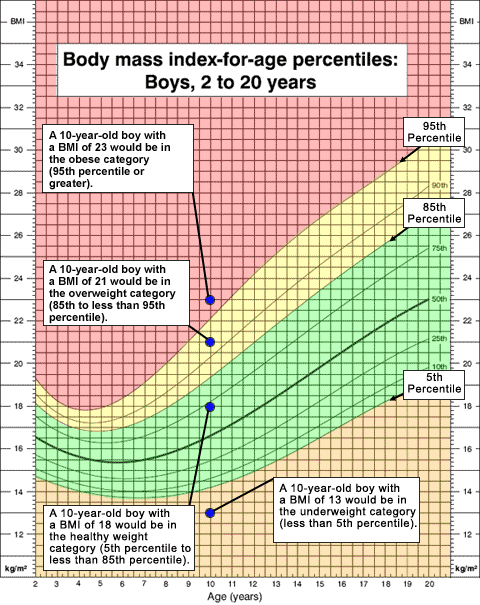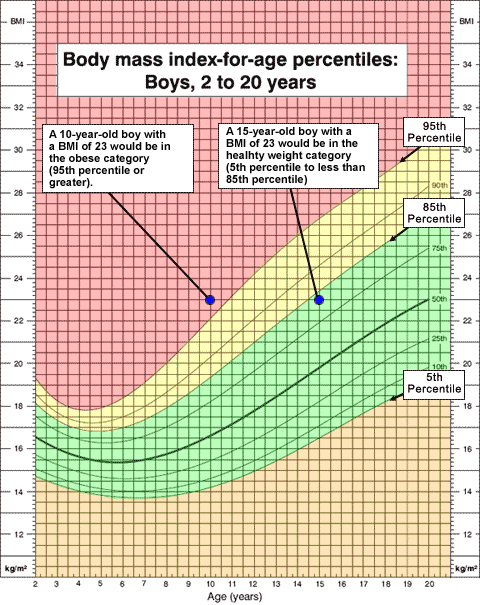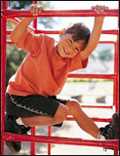About Child & Teen BMI
On this Page
- What is BMI?
- How is BMI calculated for children and teens?
- What is a BMI percentile and how is it interpreted?
- How is BMI used with children and teens?
- Is BMI interpreted the same way for children and teens as it is for adults?
- Why can’t healthy weight ranges be provided for children and teens?
- What are the BMI trends for children and teens in the United States?
- How can I tell if my child is overweight or obese?
- Can I determine if my child or teen is obese by using an adult BMI calculator?
- My two children have the same BMI values, but one is considered obese and the other is not. Why is that?
- What are the health consequences of obesity during childhood?
What is BMI?
Body Mass Index (BMI) is a person’s weight in kilograms divided by the square of height in meters. For children and teens, BMI is age- and sex-specific and is often referred to as BMI-for-age. In children, a high amount of body fat can lead to weight-related diseases and other health issues and being underweight can also put one at risk for health issues.
A high BMI can be an indicator of high body fatness. BMI does not measure body fat directly, but research has shown that BMI is correlated with more direct measures of body fat, such as skinfold thickness measurements, bioelectrical impedance, densitometry (underwater weighing), dual energy x-ray absorptiometry (DXA) and other methods1,2,3. BMI can be considered an alternative to direct measures of body fat. In general, BMI is an inexpensive and easy-to-perform method of screening for weight categories that may lead to health problems.
How is BMI calculated for children and teens?
Calculating BMI using the BMI Percentile Calculator involves the following steps:
- Measure height and weight. Refer to Measuring Children’s Height and Weight Accurately At Home for guidance.
- Use the Child and Teen BMI Calculator to calculate BMI. The BMI number is calculated using standard formulas.
What is a BMI percentile and how is it interpreted?
After BMI is calculated for children and teens, it is expressed as a percentile which can be obtained from either a graph or a percentile calculator (see links below). These percentiles express a child’s BMI relative to children in the U.S. who participated in national surveys that were conducted from 1963-65 to 1988-944. Because weight and height change during growth and development, as does their relation to body fatness, a child’s BMI must be interpreted relative to other children of the same sex and age.
BMI-for-age – Boys Growth Chart [PDF-63 KB]
BMI-for-age – Girls Growth Chart [PDF-49 KB]
BMI calculator for children and teens
The BMI-for-age percentile growth charts are the most commonly used indicator to measure the size and growth patterns of children and teens in the United States. BMI-for-age weight status categories and the corresponding percentiles were based on expert committee recommendations and are shown in the following table.
| Weight Status Category | Percentile Range |
|---|---|
| Underweight | Less than the 5th percentile |
| Normal or Healthy Weight | 5th percentile to less than the 85th percentile |
| Overweight | 85th to less than the 95th percentile |
| Obese | Equal to or greater than the 95th percentile |
The following is an example of how sample BMI numbers would be interpreted for a 10-year-old boy.
 The CDC BMI-for-age growth charts are available at: CDC Growth Charts: United States.
The CDC BMI-for-age growth charts are available at: CDC Growth Charts: United States.
How is BMI used with children and teens?
For children and teens, BMI is not a diagnostic tool and is used to screen for potential weight and health-related issues. For example, a child may have a high BMI for their age and sex, but to determine if excess fat is a problem, a health care provider would need to perform further assessments. These assessments might include skinfold thickness measurements, evaluations of diet, physical activity, family history, and other appropriate health screenings. The American Academy of Pediatrics recommends the use of BMI to screen for overweight and obesity in children beginning at 2 years old. For children under the age of 2 years old, consult the WHO standards.
Is BMI interpreted the same way for children and teens as it is for adults?
BMI is interpreted differently for children and teens even though it is calculated as weight ÷ height2. Because there are changes in weight and height with age, as well as their relation to body fatness, BMI levels among children and teens need to be expressed relative to other children of the same sex and age. These percentiles are calculated from the CDC growth charts, which were based on national survey data collected from 1963-65 to 1988-944.
Obesity is defined as a BMI at or above the 95th percentile for children and teens of the same age and sex. For example, a 10-year-old boy of average height (56 inches) who weighs 102 pounds would have a BMI of 22.9 kg/m2. This would place the boy in the 95th percentile for BMI, and he would be considered to have obesity. This means that the child’s BMI is greater than the BMI of 95% of 10-year-old boys in the reference population.
Access the CDC Growth Charts here: http://www.cdc.gov/growthcharts/clinical_charts.htm
For adults, BMI is interpreted as weight status categories that are not dependent on sex or age. Read more: How to interpret BMI for adult BMI
Why can’t healthy weight ranges be provided for children and teens?
Normal or healthy weight weight status is based on BMI between the 5th and 85th percentile on the CDC growth chart. It is difficult to provide healthy weight ranges for children and teens because the interpretation of BMI depends on weight, height, age, and sex.
What are the BMI trends for children and teens in the United States?
The prevalence of children and teens who measure in the 95th percentile or greater on the CDC growth charts has greatly increased over the past 40 years. Recently, however, this trend has leveled off and has even declined in certain age groups.
To learn more about child and teen obesity trends, visit Childhood Obesity Facts.
How can I tell if my child is overweight or obese?
CDC and the American Academy of Pediatrics (AAP) recommend the use of BMI to screen for overweight and obesity in children and teens age 2 through 19 years. For children under the age of 2 years old, consult the WHO standards. Although BMI is used to screen for overweight and obesity in children and teens, BMI is not a diagnostic tool. To determine whether the child has excess fat, further assessment by a trained health professional would be needed.
For information about the consequences of childhood obesity, its contributing factors and more, see Tips for Parents – Ideas and Tips to Help Prevent Childhood Obesity.
Can I determine if my child or teen is obese by using an adult BMI calculator?
In general, it’s not possible to do this.
The adult calculator provides only the BMI value (weight/height2) and not the BMI percentile that is needed to interpret BMI among children and teens. It is not appropriate to use the BMI categories for adults to interpret the BMI of children and teens.
However, if a child or teen has a BMI of ≥ 30 kg/m2, the child is almost certainly obese. A BMI of 30 kg/m2 is approximately the 95th percentile among 17-year-old girls and 18-year-old boys.
My two children have the same BMI values, but one is considered obese and the other is not. Why is that?
The interpretation of BMI varies by age and sex. So if the children are not the same age and the same sex, the interpretation of BMI has different meanings. For children of different age and sex, the same BMI could represent different BMI percentiles and possibly different weight status categories.
See the following graphic for an example for a 10-year-old boy and a 15-year-old boy who both have a BMI-for-age of 23. (Note that two children of different ages are plotted on the same growth chart to illustrate a point. Normally the measurement for only one child is plotted on a growth chart.)

What are the health consequences of obesity during childhood?
Health risks now
- Childhood obesity can have a harmful effect on the body in a variety of ways.
- High blood pressure and high cholesterol, which are risk factors for cardiovascular disease (CVD). In one study, 70% of obese children had at least one CVD risk factor, and 39% had two or more.6
- Increased risk of impaired glucose tolerance, insulin resistance and type 2 diabetes.7
- Breathing problems, such as sleep apnea, and asthma.8,10
- Joint problems and musculoskeletal discomfort.8,11
- Fatty liver disease, gallstones, and gastro-esophageal reflux (i.e., heartburn). 7,8,9
- Psychological stress such as depression, behavioral problems, and issues in school.12,13,14
- Low self-esteem and low self-reported quality of life.12,14,15,16
- Impaired social, physical, and emotional functioning.12
Health risks later
- Obese children are more likely to become obese adults.17 Adult obesity is associated with a number of serious health conditions including heart disease, diabetes, and some cancers.18
- If children are overweight, obesity in adulthood is likely to be more severe.17
References
1Garrow, J.S. & Webster, J., 1985. Quetelet’s index (W/H2) as a measure of fatness. Int. J. Obes., 9(2), pp.147–153.
2Freedman, D.S., Horlick, M. & Berenson, G.S., 2013. A comparison of the Slaughter skinfold-thickness equations and BMI in predicting body fatness and cardiovascular disease risk factor levels in children. Am. J. Clin. Nutr., 98(6), pp.1417–24.
3Wohlfahrt-Veje, C. et al., 2014. Body fat throughout childhood in 2647 healthy Danish children: agreement of BMI, waist circumference, skinfolds with dual X-ray absorptiometry. Eur. J. Clin. Nutr., 68(6), pp.664–70.
4Kuczmarski, R.J. et al., 2002. 2000 CDC Growth Charts for the United States: methods and development. Vital Health Stat. 11., 11(246), pp.1–190.
5Ogden CL, Flegal KM, Carroll MD, Johnson CL. Prevalence and trends in overweight among US children and adolescents, 1999-2000. JAMA. 2002;288:1728–32.
6Freedman DS, Mei Z, Srinivasan SR, Berenson GS, Dietz WH. Cardiovascular risk factors and excess adiposity among overweight children and adolescents: the Bogalusa Heart Study. J Pediatr. 2007;150(1):12—17.e2.
7Whitlock EP, Williams SB, Gold R, Smith PR, Shipman SA. Screening and interventions for childhood overweight: a summary of evidence for the US Preventive Services Task Force. Pediatrics. 2005;116(1):e125—144.
8Han JC, Lawlor DA, Kimm SY. Childhood obesity. Lancet. May 15 2010;375(9727):1737—1748.
9Vos MB, McClain CJ. Nutrition and nonalcoholic fatty liver disease in children. Current Gastroenterology Reports. Jun 2008; 10(3): 308-15.
10Sutherland ER. Obesity and asthma. Immunol Allergy Clin North Am. 2008;28(3):589—602, ix.
11Taylor ED, Theim KR, Mirch MC, et al. Orthopedic complications of overweight in children and adolescents. Pediatrics. Jun 2006;117(6):2167—2174.
12Morrison KM., et al. Association of depression & health related quality of life with body composition in children and youth with obesity. Journal of affective disorders 172 (2015): 18-23.
13Mustillo S, et al. Obesity and psychiatric disorder: developmental trajectories. Pediatrics 111.4 (2003): 851-859.
14Halfon N, Larson K, and Slusser W. Associations between obesity and comorbid mental health, developmental, and physical health conditions in a nationally representative sample of US children aged 10 to 17. Academic pediatrics 13.1 (2013): 6-13.
15Schwimmer JB, Burwinkle TM, and Varni JW. Health-related quality of life of severely obese children and adolescents. Jama 289.14 (2003): 1813-1819.
16Taylor VH., et al. The impact of obesity on quality of life. Best Practice & Research Clinical Endocrinology & Metabolism 27.2 (2013): 139-146.
17Cunningham SA, Kramer MR, Venkat Narayan KM. Incidence of childhood obesity in the United States. New England Journal of Medicine 2014; 370 : 403-411.
18Kelsey MM, Zaepfel A, Bjornstad P, Nadeau KJ. Age-related consequences of childhood obesity. Gerontology 2014; 60(3):222-8.
- Page last reviewed: May 15, 2015
- Page last updated: May 15, 2015
- Content source:


 ShareCompartir
ShareCompartir
